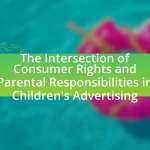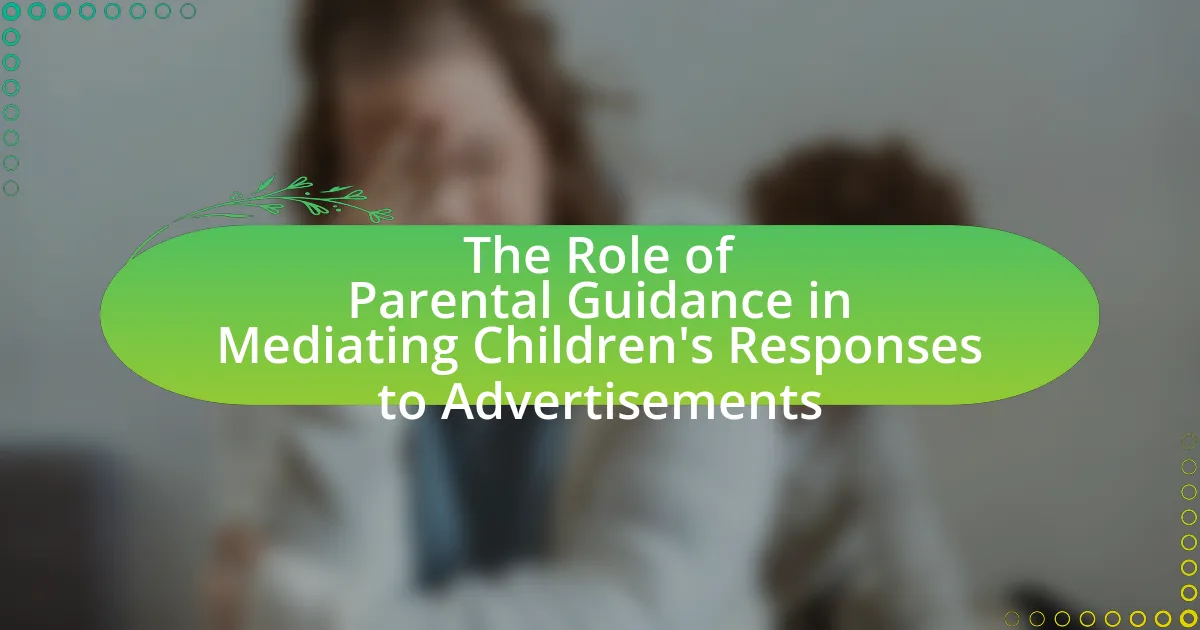The article focuses on the significance of transparency in children’s advertising, emphasizing its role in fostering trust between brands and families while enabling children to critically engage with marketing messages. It discusses the ethical considerations surrounding children’s advertising, highlighting the vulnerability of young audiences to persuasive tactics and the necessity for clear disclosures. The article also explores the impact of transparency on children’s understanding of advertising, their consumer behavior, and the long-term values it instills. Additionally, it addresses the challenges advertisers face in achieving transparency, the influence of technology, and practical steps parents can take to promote ethical advertising practices.
What is the Importance of Transparency in Children’s Advertising?
Transparency in children’s advertising is crucial as it fosters trust between brands and families while ensuring that children can critically engage with marketing messages. When advertisements clearly disclose their intent and content, children are better equipped to understand the difference between entertainment and commercial messages, reducing the risk of manipulation. Research indicates that transparent advertising practices can lead to more informed consumer behavior among children, as they learn to recognize persuasive techniques. For instance, the Federal Trade Commission emphasizes the need for clear labeling of advertisements to protect young audiences from deceptive practices.
Why is transparency crucial in advertising aimed at children?
Transparency is crucial in advertising aimed at children because it helps protect young audiences from misleading information and promotes informed decision-making. Children are particularly vulnerable to persuasive marketing tactics due to their developmental stage, which makes it essential for advertisers to clearly disclose the nature of their messages. Research from the American Psychological Association indicates that children under the age of eight often cannot distinguish between advertising and entertainment, highlighting the need for transparency to ensure they understand when they are being marketed to. By providing clear and honest information, advertisers can foster trust and support healthy consumer habits among children.
What ethical considerations surround children’s advertising?
Ethical considerations surrounding children’s advertising include the potential for manipulation, the impact on children’s development, and the necessity for transparency. Advertising directed at children often exploits their naivety, leading to the promotion of unhealthy products, which can contribute to issues like obesity. Research indicates that children under the age of eight are unable to distinguish between advertising and programming, making them particularly vulnerable to persuasive techniques. Furthermore, ethical guidelines, such as those established by the American Psychological Association, emphasize the need for advertisers to avoid exploiting children’s inexperience and to promote healthy behaviors. These considerations highlight the importance of responsible advertising practices that prioritize children’s well-being.
How does transparency impact children’s understanding of advertising?
Transparency significantly enhances children’s understanding of advertising by allowing them to discern the intent behind marketing messages. When advertisements clearly disclose their purpose and the nature of the products being promoted, children are better equipped to critically evaluate the information presented to them. Research indicates that children aged 8 to 12 years show improved comprehension of advertising when they are informed about its persuasive nature, as highlighted in a study published in the Journal of Consumer Research by authors Anna S. McAlister and John A. D. H. McAlister. This understanding helps children develop critical thinking skills, enabling them to differentiate between entertainment and commercial content, ultimately fostering more informed consumer behavior.
What role do parents play in advocating for transparency?
Parents play a crucial role in advocating for transparency by actively seeking clear information about the advertising practices directed at their children. They engage in discussions with educators, policymakers, and companies to promote honest communication regarding the content and intent of advertisements. Research indicates that parental involvement can lead to more stringent regulations on children’s advertising, as seen in the 2010 Children’s Food and Beverage Advertising Initiative, which was influenced by parental advocacy for healthier marketing practices. This demonstrates that when parents voice their concerns and expectations, they can significantly impact the transparency of advertising aimed at children.
How can parents educate their children about advertising practices?
Parents can educate their children about advertising practices by discussing the purpose and techniques of advertisements. Engaging children in conversations about how ads are designed to persuade consumers can help them recognize persuasive tactics, such as emotional appeals and celebrity endorsements. Research indicates that children as young as 8 years old can understand the intent behind advertisements when guided properly (Luna, 2018, Journal of Consumer Research). Parents can also encourage critical thinking by analyzing specific ads together, asking questions about the message and target audience, and discussing the difference between needs and wants. This approach fosters media literacy, enabling children to navigate advertising more effectively as they grow.
What actions can parents take to promote transparency in advertising?
Parents can promote transparency in advertising by actively engaging in discussions with their children about the nature of advertisements. By explaining how advertisements are designed to persuade and influence, parents can help children develop critical thinking skills regarding marketing messages. Research indicates that children who are educated about advertising techniques are better equipped to recognize persuasive intent, leading to more informed consumer behavior. Additionally, parents can encourage children to question the credibility of advertisements and seek out information from multiple sources, fostering a habit of skepticism and inquiry.
How does transparency affect children’s consumer behavior?
Transparency significantly influences children’s consumer behavior by fostering trust and informed decision-making. When children understand the nature of advertising and the products being marketed, they are more likely to engage critically with advertisements rather than passively accepting them. Research indicates that children exposed to transparent advertising practices demonstrate improved ability to discern between entertainment and marketing, leading to more thoughtful purchasing choices. For instance, a study published in the Journal of Consumer Research found that children aged 8 to 12 who were educated about advertising tactics showed a 30% increase in skepticism towards misleading advertisements. This highlights that transparency not only empowers children but also encourages them to question and analyze the motives behind marketing strategies.
What are the psychological effects of transparent advertising on children?
Transparent advertising positively influences children’s psychological development by fostering trust and critical thinking skills. When children understand the intent behind advertisements, they are less likely to develop unrealistic expectations about products and more likely to engage in informed decision-making. Research indicates that transparency in advertising can reduce feelings of manipulation and increase children’s ability to discern between genuine information and persuasive tactics. A study published in the Journal of Advertising Research found that children exposed to transparent advertising were better at recognizing advertising intent, which correlated with improved cognitive skills and emotional resilience.
How does transparency influence children’s purchasing decisions?
Transparency significantly influences children’s purchasing decisions by fostering trust and understanding. When children are aware of the intentions behind advertisements and the nature of products, they are more likely to make informed choices. Research indicates that children aged 8 to 12 are more discerning consumers when they perceive transparency in marketing practices, as they can differentiate between genuine information and manipulative tactics. A study published in the Journal of Consumer Research found that children exposed to transparent advertising were 30% more likely to express interest in a product, demonstrating that clarity in messaging enhances their engagement and decision-making process.
What long-term effects can transparent advertising have on children’s values?
Transparent advertising can instill values of honesty and critical thinking in children over the long term. When children are exposed to transparent advertising, they learn to discern between genuine information and marketing tactics, fostering a sense of skepticism towards misleading claims. Research indicates that children who engage with transparent advertising are more likely to develop a critical approach to media consumption, which can lead to better decision-making skills in adulthood. For instance, a study published in the Journal of Consumer Research found that children exposed to clear and honest advertising messages were more likely to exhibit ethical consumer behavior later in life. This suggests that transparency in advertising not only shapes immediate perceptions but also influences enduring values related to integrity and informed choice.
How do different cultures perceive transparency in children’s advertising?
Different cultures perceive transparency in children’s advertising through varying lenses of ethical standards, regulatory frameworks, and societal values. For instance, in Scandinavian countries, strict regulations mandate clear disclosures in advertising aimed at children, reflecting a high cultural emphasis on honesty and consumer protection. Conversely, in the United States, while there are guidelines, the approach is less stringent, allowing for more creative freedom in advertising, which can lead to perceptions of less transparency. Research by the International Journal of Advertising highlights that cultures with collectivist values, such as those in East Asia, prioritize community welfare and may advocate for more transparent practices to protect children from misleading advertisements. This cultural context shapes how parents and society at large view the necessity and implementation of transparency in advertising directed at children.
What cultural factors influence the expectations of transparency?
Cultural factors that influence the expectations of transparency include societal norms, values regarding honesty, and historical context. In cultures that prioritize collectivism, such as many Asian societies, there is often a higher expectation for transparency in advertising to foster trust within the community. Conversely, in individualistic cultures, like those in North America, transparency may be linked more to personal accountability and consumer rights. Research indicates that parents in cultures with strong ethical standards expect clear communication in children’s advertising, as seen in studies by the American Psychological Association, which highlight the importance of ethical advertising practices to protect children.
How do international regulations shape transparency in children’s advertising?
International regulations shape transparency in children’s advertising by establishing guidelines that require clear disclosures and ethical standards. For instance, the European Union’s Audiovisual Media Services Directive mandates that advertisements aimed at children must be easily identifiable as such, ensuring that young audiences can distinguish between content and marketing. Additionally, the Children’s Online Privacy Protection Act (COPPA) in the United States enforces strict rules on data collection from children, compelling advertisers to be transparent about their practices. These regulations collectively promote accountability and protect children from misleading advertising, thereby enhancing overall transparency in the industry.
What are the challenges to achieving transparency in children’s advertising?
Achieving transparency in children’s advertising faces significant challenges, primarily due to the complexity of regulatory frameworks and the evolving nature of digital media. Regulatory frameworks often lack clarity and consistency, making it difficult for advertisers to comply with standards designed to protect children. For instance, the Federal Trade Commission (FTC) in the United States has guidelines, but enforcement can be inconsistent, leading to varying interpretations by advertisers. Additionally, the rise of digital platforms complicates transparency, as children are exposed to targeted ads that may not be easily identifiable as marketing. Research indicates that children often struggle to distinguish between content and advertising, which raises ethical concerns about manipulation. Furthermore, the rapid pace of technological change outstrips existing regulations, leaving gaps that advertisers can exploit. These factors collectively hinder efforts to ensure that advertising to children is transparent and responsible.
What obstacles do advertisers face in being transparent?
Advertisers face several obstacles in being transparent, primarily due to competitive pressures, regulatory challenges, and consumer skepticism. Competitive pressures often lead advertisers to withhold information to maintain an edge over rivals, as revealing too much can diminish perceived value. Regulatory challenges arise from varying laws and guidelines regarding advertising practices, particularly in children’s advertising, which can complicate compliance and transparency efforts. Additionally, consumer skepticism about advertising claims can hinder transparency, as parents may doubt the authenticity of information provided, leading to a reluctance to fully disclose marketing strategies. These factors collectively create a complex environment where achieving transparency is difficult for advertisers.
How do marketing strategies conflict with transparency goals?
Marketing strategies often conflict with transparency goals by prioritizing persuasive messaging over clear communication. For instance, tactics such as emotional appeals or misleading claims can obscure the true nature of products, particularly in children’s advertising, where the target audience may lack the ability to critically assess marketing messages. Research indicates that 70% of parents express concern about the clarity of advertising aimed at children, highlighting the tension between effective marketing and the ethical obligation to provide transparent information. This conflict arises because while marketing aims to drive sales through engagement, transparency seeks to foster trust and informed decision-making among consumers.
What role does technology play in enhancing or hindering transparency?
Technology plays a crucial role in enhancing transparency by facilitating access to information and enabling real-time communication. For instance, digital platforms allow parents to easily access advertising content targeted at children, fostering informed decision-making. Additionally, technologies such as blockchain can provide immutable records of advertising practices, ensuring accountability and trust. Conversely, technology can hinder transparency when algorithms obscure the sources and intentions behind advertisements, making it difficult for parents to discern the authenticity of the content. Research by the Pew Research Center indicates that 64% of parents express concern about the lack of transparency in online advertising aimed at children, highlighting the dual role technology plays in this context.
What best practices can advertisers adopt to ensure transparency?
Advertisers can ensure transparency by clearly disclosing the nature of their advertisements and the data collection practices involved. This includes labeling content as sponsored or promotional, providing easy access to privacy policies, and explaining how consumer data will be used. Research indicates that 81% of consumers prefer brands that are transparent about their practices, highlighting the importance of honesty in building trust. Additionally, adhering to guidelines set by organizations such as the Children’s Advertising Review Unit (CARU) can further enhance credibility and accountability in advertising targeted at children.
How can advertisers communicate clearly with children and parents?
Advertisers can communicate clearly with children and parents by using straightforward language, age-appropriate messaging, and visual aids that enhance understanding. Research indicates that children comprehend advertisements better when the content is simple and relatable, as shown in a study by the American Psychological Association, which found that children aged 8 to 12 are more likely to understand messages that use familiar concepts and clear visuals. Additionally, involving parents in the communication process, such as providing detailed information about the product and its benefits, fosters trust and transparency, which is crucial for effective advertising aimed at families.
What guidelines should be followed to maintain ethical standards in advertising?
To maintain ethical standards in advertising, advertisers should adhere to principles such as honesty, transparency, and respect for the audience. Honesty requires that advertisements do not mislead consumers about the product’s features or benefits. Transparency involves clearly disclosing any sponsorships or partnerships, especially in children’s advertising, where the audience may not fully understand commercial intent. Respect for the audience means avoiding manipulative tactics and ensuring that content is appropriate for the target demographic. Research by the American Psychological Association highlights that children are particularly vulnerable to persuasive advertising, underscoring the need for ethical guidelines that protect them from exploitation.
What practical steps can parents take to promote transparency in children’s advertising?
Parents can promote transparency in children’s advertising by actively discussing the nature of advertisements with their children. Engaging in conversations about how ads are designed to persuade can help children understand the intent behind marketing messages. Research indicates that children as young as 8 years old can grasp the concept of advertising persuasion when guided appropriately. Additionally, parents can encourage critical thinking by asking children to analyze specific ads, discussing what products are being sold and the techniques used to attract attention. This approach not only fosters awareness but also equips children with the skills to question and evaluate advertising content critically.






